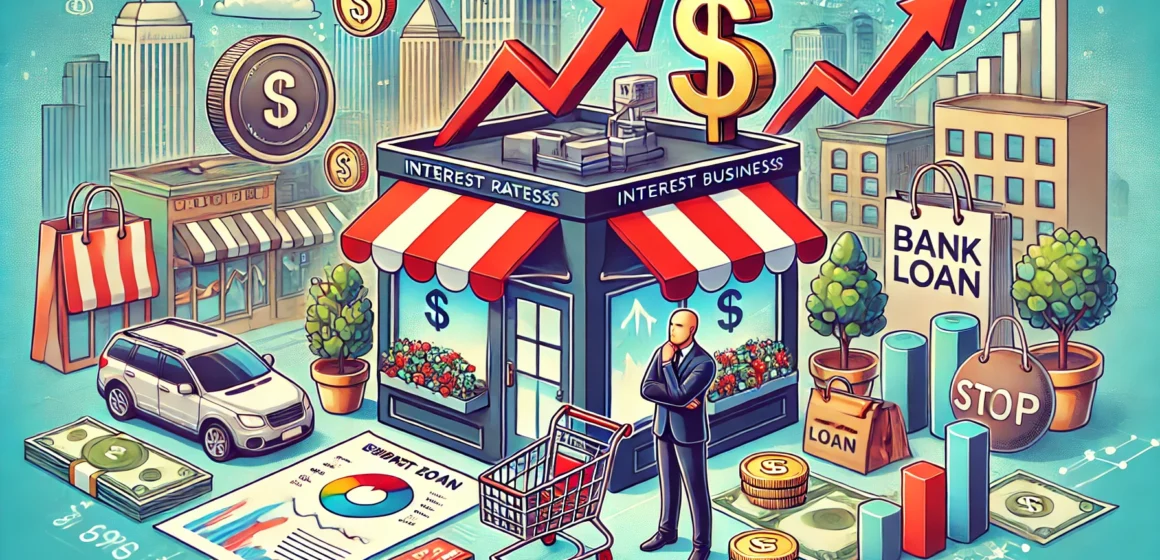Interest rates are a crucial economic factor influencing the financial health of businesses,
particularly for small businesses that often rely on borrowing to manage cash flow and invest
in growth. Changes in interest rates—whether through central bank policy adjustments or
market fluctuations—have a significant impact on small businesses’ ability to access
affordable credit, manage operational costs, and plan for the future. Here’s a look at how
interest rates impact small businesses and why understanding this dynamic is essential for
entrepreneurs.
1.Cost of Borrowing
When interest rates rise, the cost of borrowing increases. Small businesses that depend on
loans or lines of credit to finance day-to-day operations, expand inventory, or invest in new
equipment will face higher monthly payments on any outstanding debt. This can strain cash
flow, making it more difficult to cover other operational expenses or invest in growth
opportunities.
Example: A small retail store with a variable-rate loan may see its monthly payment increase
significantly during a period of high interest rates, cutting into profits and limiting the owner’s
ability to hire or invest in marketing.
2.Access to Capital
Interest rate levels also influence banks’ willingness to lend. When rates are high, lenders
often become more cautious, tightening their lending criteria. Small businesses, especially
startups or companies with limited credit histories, may find it harder to secure financing
when interest rates are elevated. This can slow business expansion, delay product launches,
or prevent companies from seizing new opportunities.
Impact: Limited access to affordable capital can hinder a small business’s growth potential,
making it essential to maintain a strong credit profile and explore alternative financing
options.
3.Cash Flow and Operational Costs
Higher interest rates can affect cash flow, as businesses with existing loans need to allocate
more money toward debt repayment. With less cash available, small businesses may need
to reduce spending in other areas, such as inventory, marketing, or staffing. This can limit
growth potential and decrease competitiveness, particularly if competitors have access to
lower-cost capital.
Benefit: Conversely, during periods of low interest rates, small businesses may have more
cash available to invest in new projects, hire additional staff, or expand their operations.
4.Impact on Consumer Spending
Interest rates also impact consumer behavior. When rates rise, consumer spending typically
decreases as the cost of credit (such as credit card purchases and personal loans) goes up.
Reduced consumer spending can lead to lower revenue for small businesses, especially in
industries that rely heavily on discretionary spending, such as retail, hospitality, and
entertainment.
Example: A local restaurant may experience fewer customers during a period of high interest
rates, as consumers cut back on dining out to save money on interest-bearing debt
5.Strategic Planning and Investment Decisions
The level of interest rates can influence a small business’s long-term planning and
investment strategies. Low interest rates can encourage businesses to take on debt to
expand operations or invest in new projects, while high rates may lead to more conservative
financial planning. Small business owners need to monitor interest rate trends to make
informed decisions about timing and investment priorities.
Tip: Planning ahead and securing fixed-rate loans during periods of low interest rates can
provide stability and protect against rate fluctuations in the future.
Navigating Interest Rate Changes as a Small Business
Understanding how interest rates affect your business is essential for making informed
financial decisions. Here are some strategies to navigate changing interest rates:
● Consider Fixed-Rate Loans: Fixed-rate loans offer stability by locking in interest
rates, protecting against future increases.
● Build a Cash Reserve: A cash reserve can provide a buffer during periods of high
interest rates, helping cover unexpected costs.
● Monitor Economic Trends: Staying informed about interest rate trends and
economic conditions can help business owners plan ahead.
● Diversify Financing Options: Explore alternative financing, such as grants or
investor funding, to reduce reliance on interest-based loans
Conclusion
Interest rates are a powerful economic force shaping the financial landscape for small
businesses. By understanding how rates impact borrowing costs, cash flow, and consumer
behavior, small business owners can make smarter financial decisions that support
long-term stability and growth. Whether rates are high or low, a strategic approach to
managing debt and cash flow will empower small businesses to weather changes in the
economic environment and thrive in any market.




Leave a Reply